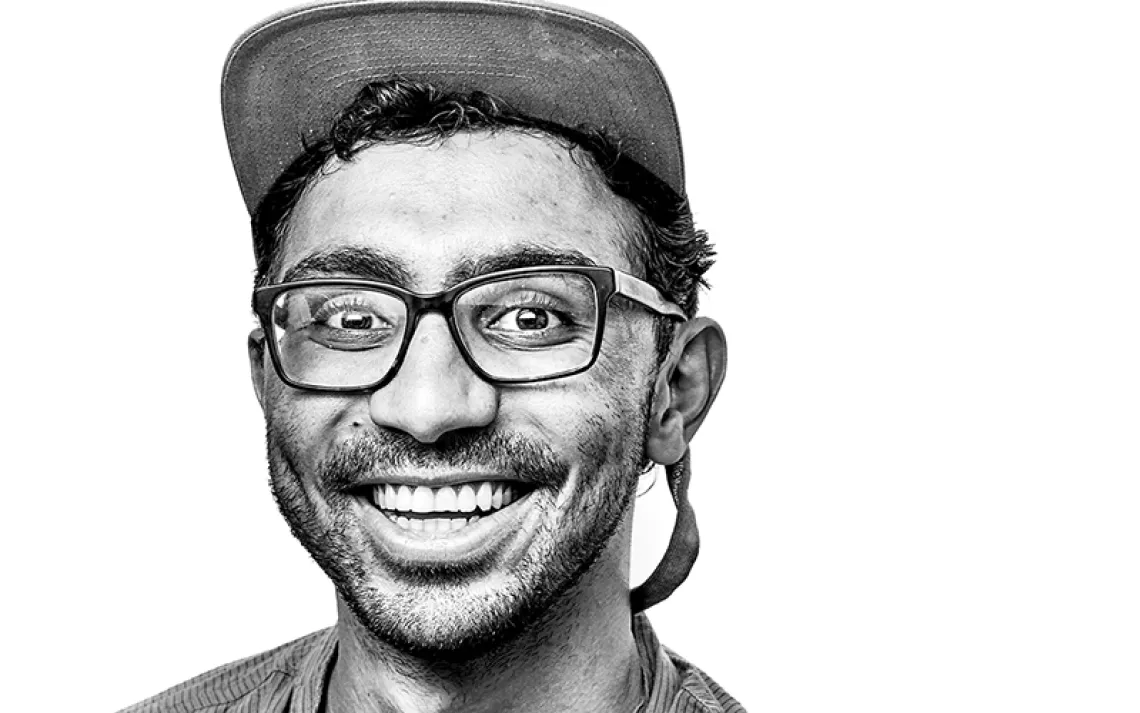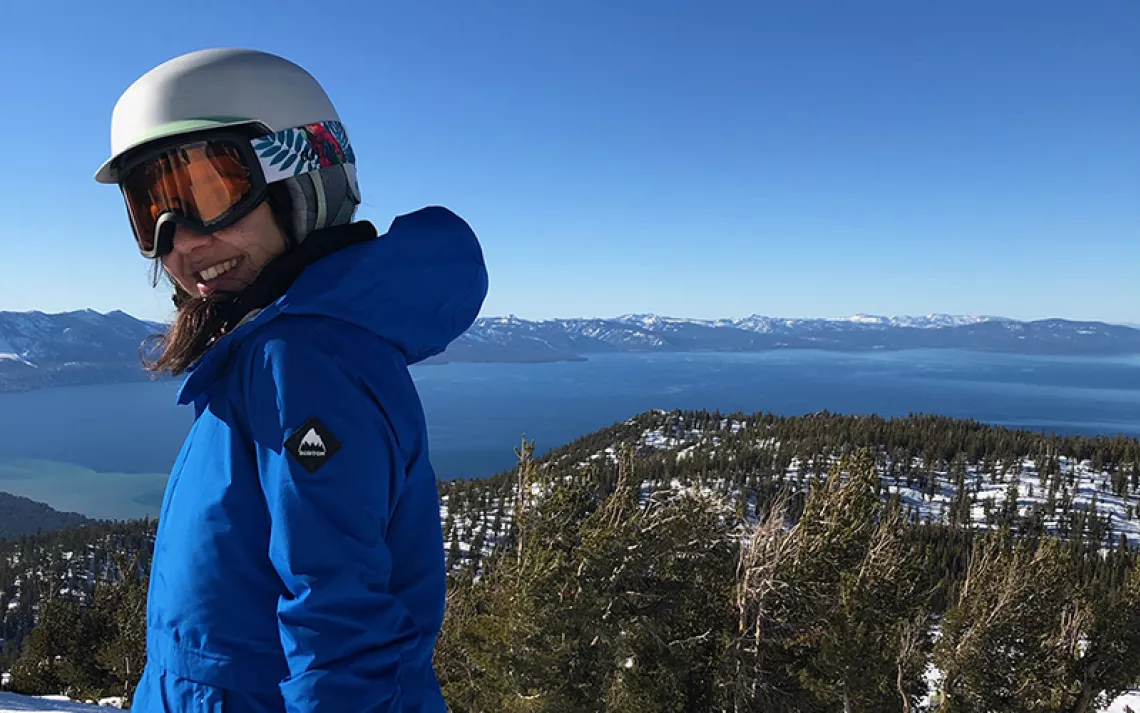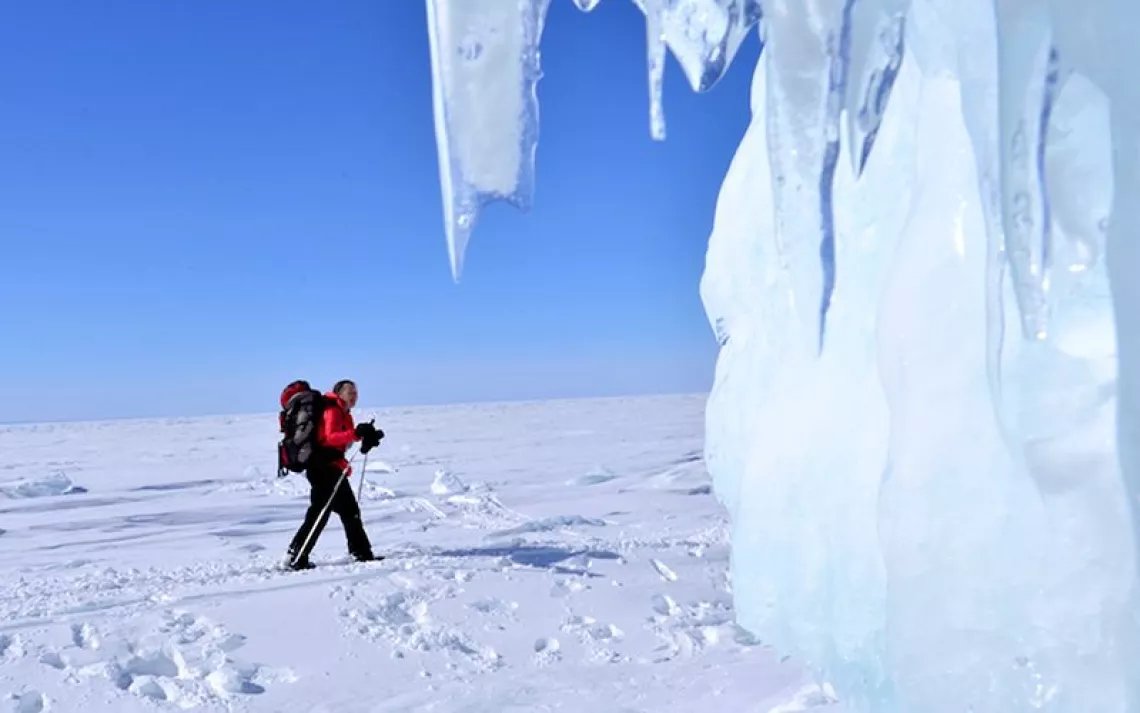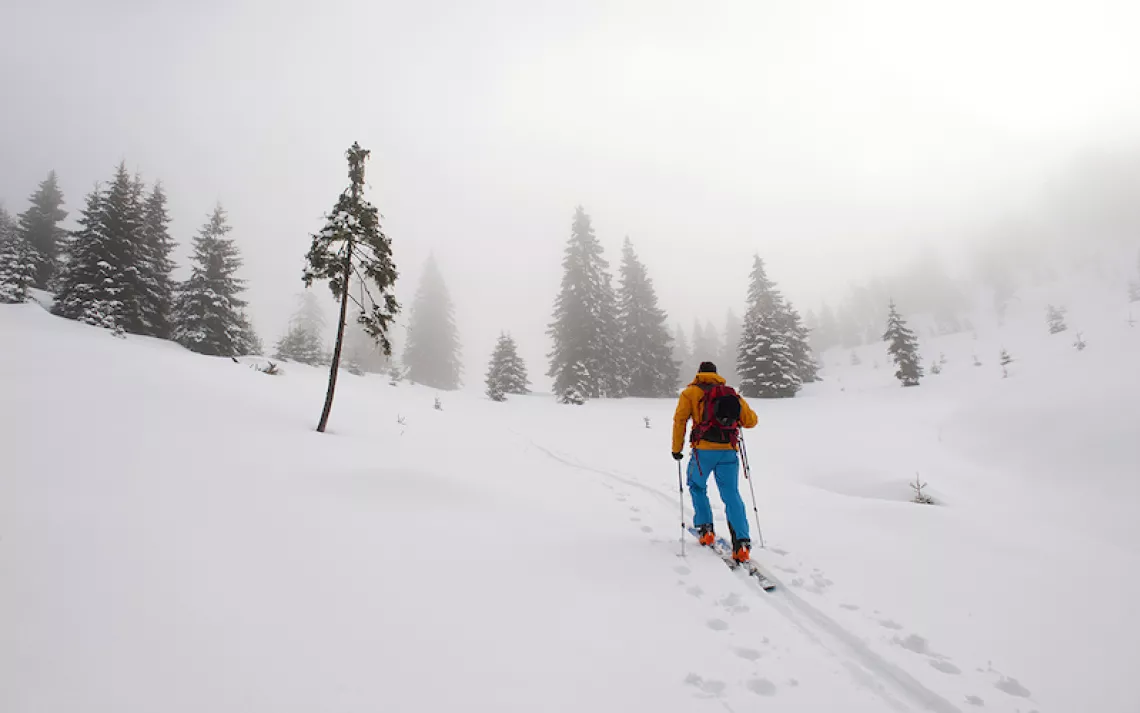Uphill Skiing: It’s a Movement
From the backcountry to the resort, skinning accommodates various ski lifestyles

Full moon dinner at the Cliffhouse, Buttermilk Ski Area | Photo by Dan Bayer
On a recent dark and snowy February night, my husband and I buckled our ski boots and clicked into our bindings. There was a full moon, but we couldn’t see it from behind the billowing clouds. We skied down groomed slopes from The Cliffhouse at the top of Buttermilk Ski Area in Aspen, Colorado, head lamps illuminating our way. The falling snow sparkled in our beams of light. The world was still, save for our own movement. We passed a handful of people who were on their way up to The Cliffhouse for the monthly full moon dinner—a regular after-hours winter event that rewards those willing to work up an appetite slogging 1,653 vertical feet.
There’s a beauty to uphill skiing: It puts you in your body in a way no other winter sport can, and can take you places where you don’t necessarily expect to go. All that’s required is patience and commitment (and specialty gear—more on that in a minute). Fitness helps, too, but it’s not essential for starting; endurance comes quickly through the act of doing.
I’d spent the earlier part of the day skinning at Snowmass with Aspen local and ski instructor Ted Mahon. We climbed from the village base up about 2,720 vertical feet to Elk Camp, elevation 11,325 feet. Clouds obscured what Mahon promised were stunning views of the Maroon Bells, but I didn’t care. The effort to get there had induced the ski equivalent of a runner’s high. Even though the day was cold and the people getting off the chairlift shivered and complained about numb fingers, I was warm and limber.
We hadn’t ventured uphill in traditional ski equipment, but in alpine touring (AT) gear, which consists of specialty bindings that free the heel for the climb up (kind of like cross-country skiing) and lock it down for the descent. AT boots are lighter and more comfortable than heavy downhill ones. I used adjustable poles, extending them for leverage during the climb and compressing them for the downhill. For uphill traction, we slapped skins—adhesive mohair/polyester strips—onto the bottom of our skis, hence the label “skinning” to describe skiing uphill. (Snowboarders can get specialty splitboards with unique bindings for uphill skinning.)

Photo courtesy of Rachel Walker
Alpine Touring gear has long been popular with backcountry skiers—I first discovered it when I was living in Jackson, Wyoming, in my twenties. Back then exploring the Teton backcountry on skis became an essential part of my life. Many backcountry skiers are in constant search of untouched powder snow, but for me, the initial appeal came from skinning—downhill powder runs were an added bonus.
As a young woman trying to forge a career and fall in love and maintain friendships, I relished the sense of accomplishment skinning delivered. If I could skin 3,000 feet up a lone peak in the Tetons, surely I could find the confidence to pursue work I loved and a community where I belonged.
Skinning took me to magnificent landscapes where I felt small in a good way—I learned concrete skills and developed esoteric, personal insights. My identity was so rooted in my love of backcountry skinning that when I got pregnant in 2009, I cried because I was afraid of how children would change my lifestyle, especially in the winter.
Little did I know then that skinning uphill at developed ski resorts would become my salve. To my surprise, after my kids were born, I became much more risk-averse and mostly avoided backcountry skiing. But I still wanted to skin, and soon discovered that many resorts in my home state of Colorado were happy to accommodate uphill skiers like myself.
Who are these people? They’re a diverse crowd. Some are interested in “ski-mo” (ski mountaineering) racing and going light and fast. Others enjoy going slow and steady. The common denominator, at least as far as I can tell, is that the people skiing uphill at resorts enjoy the physical effort, the beauty, and the safe access—which is far from guaranteed in the backcountry.
Since this year’s ski season started around Thanksgiving, I’ve skied uphill almost every weekend. My husband and I alternate between skiing with the kids and skinning so we each get a chance to do both. Sometimes I start off in the pre-dawn morning and skin as the sun rises. Other times, I climb while the lifts are running, and downhill skiers and snowboarders pass me, occasionally calling out, “You’re going the wrong way!” That’s happening less, though, as more uphill skiers normalize the activity.
For years, many resorts banned uphill skiing. Officials worried that allowing uphill skiing would open them up to lawsuits. One resort executive in Oregon told me in the early 2000s that to allow uphill skiing during regular business hours was “a disaster waiting to happen.” He didn’t elaborate, and I still don’t understand how that disaster would manifest. I’ve heard some resort officials complain that uphill skiers don’t buy passes and may ride mid-mountain lifts, where operators don’t check for ski passes. That probably happens, but I suspect the amount of people who skin to avoid purchasing a ski pass are few and far between—skinning is too much effort, too self-selective, to be a reasonable hack for someone who blanches at a $180 ski pass.
What was true for me 20 years ago in Jackson is still true today: I feel powerful and accomplished when I skin. I love being warm from my own effort, even when the cold air frosts the sweat on my hat and hair. Skinning is a solid aerobic workout, and it’s also methodical in the way trail running or road biking is. When I skin, I sometimes zone out and relax my mind. Other times my imagination runs wild and I have to stop to jot down story ideas or flashes of insight.
During my recent trip to Aspen, I marveled at how much skinning is part of the ski culture there. (Full disclosure: If I could afford it, I’d move to Aspen tomorrow.) Not only has skinning always been allowed at all four of Aspen’s developed mountains, hundreds of people ski up for the monthly full moon dinners, and dozens skin up Buttermilk every Friday morning for the free pancake breakfast known as the Friday Uphill Breakfast Club. Four Mountain Sports, a ski shop at all four base villages, rents uphill gear, including skins and adjustable poles. Ski school offers uphill lessons and monthly locals’ clinics to introduce beginners to the uphill fundamentals.

Courtesy of Aspen Ski Company
Closer to my home in Boulder, I frequently skin up Mary Jane at Winter Park Resort, which allows uphill skiing all day long. I’ve held a business meeting while skinning up Eldora, and I’ve skinned up Vermont’s Mad River Glen with extended family. I know a handful of California resorts now allow uphill skiing. In fact, the uphill resort skiing movement is growing to such an extent that Backcountry magazine now publishes an annual uphill skiing policy guide that lists by state where uphill skiing is allowed.
After the full moon dinner at The Cliffhouse, I skied down as slowly as I could. I wanted to prolong the magic of the moment and to savor that feeling of sweet perseverance and accomplishment.
These days, I am not as spontaneous or adventurous as I once was. Uphill skiing returns me to the mindset of being present and having fun. Ten years ago, if you told me I’d be writing an ode to uphill skiing at developed resorts, I would have laughed—nothing but pristine backcountry for me, thank you very much. I see now how limiting that perspective can be. After all, if I’ve learned anything since discovering the power of skinning, it’s this: There is no one right way to ski uphill. All that matters is to keep moving forward.
 The Magazine of The Sierra Club
The Magazine of The Sierra Club



